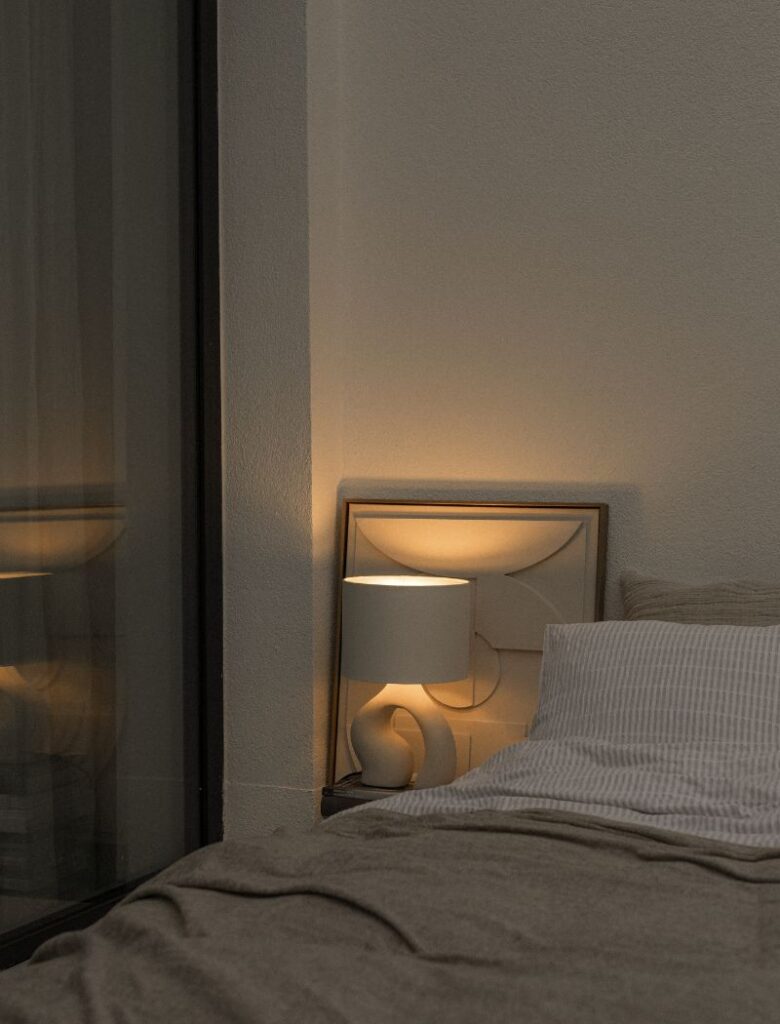This post may contain affiliate links, which means I’ll receive a commission if you purchase through my links, at no extra cost to you. Please read full disclosure for more information.

Between binge-watching your favorite show, doom scrolling and falling asleep with the TV on or repeating ‘one last reply’ before you go to bed, what’s causing your sleep issues? While these may affect your sleep, your environment might be more important. Here are 10 things that may interfere with your sleep quality.
1. Alarm Clock
Whether you set your alarms on your phone or have one of those cool LED light alarm clocks, the glowing lights can disrupt your sleep and the loud alarm sounds can be too harsh a wake-up call. Change to an analog clock to avoid the glaring numbers of a digital alarm clock. Look for one with features like non-ticking, gentle wake, and gentle snooze light functions.
Alternatively, you can go for a smart sunrise alarm clock that only needs your smartphone for setup. Some come with built-in nature-inspired sleep sounds with pink, white, and brown noise options. They wake you gently by mimicking the sunrise and playing gentle sounds of your choice.
2. Sheer Curtains
If you have thin curtains that let in significant amounts of light while you sleep, it may cause bad sleep quality. Enhance your sleep with blackout curtains. They reduce sleep disruptions by blocking light from outside. Blackout curtains come in all colors and styles, so you can find one that suits your style.
Maybe you chose your current curtains for their unique pattern or fabric. Instead of replacing them, you can add thick lining behind them or get a set of blackout curtains and hang them behind yours.
3. Wrong Temperature
Reduce the temperature to sleep well. The ideal temp ranges from 66-70 degrees Fahrenheit for optimum comfort. In addition to the ambient temperature, your bedding and whether you sleep in pajamas, nude or semi-nude all play a role. In summer, a light blanket or duvet will do.
Warm your bed with the heated blanket in winter but switch it off afterward. Although switching off your electric blanket before you fall asleep may seem counterintuitive, manufacturers know what they’re talking about. Your body’s core temperature needs to be several degrees lower than what it is during the day for a good night’s sleep.
4. Wrong Pillow and Scratchy Bedding
Your pillow and sheets are the most important bedding items to optimize since you are in direct contact with both while you sleep.
A good pillow will prevent muscle stiffness, nerve pain, and the discomfort of using the wrong one over time. If you sleep on your back, try a medium-thick pillow. Side sleepers will appreciate firm pillows while stomach sleepers can prevent neck pain with a softer pillow.
Keep sheets clean and smelling fresh –with lavender or sleep spray to increase melatonin. If you start to feel rough patches, see piling and baubles or notice smells that stick, consider replacing them. You should replace your sheets every 100 washes, so when signs of wear and tear appear, take it as an opportunity to buy the 300 thread count sheets you’ve been eyeing.
5. Subtle Insistent Noise
Noises like traffic on the road below your apartment block or construction can cause occasional disruptions. But it’s the persistent subtle noise that really gets to you, especially if you’re a light sleeper. Maybe it’s the creaky old pipes in your building or doors opening and closing in the apartment downstairs.
The solution? White noise. Invest in a white noise machine or play white noise recordings from YouTube — if you can resist grabbing your phone to scroll through reels and shorts.
6. Charger Lights
You’ve seen and read the research about blue light and its effect on the sleep hormone melatonin. You need it to maintain your circadian rhythm and maintain good sleep. Blue light can disrupt your melatonin levels and ultimately your sleep cycle.
Move all the tech and chargers to another room and set up a charging station there. Even your wireless charger light can impact your sleep so it’s better off hidden from view. If you work from home and your bedroom is your office, switch off all computer equipment completely a few hours before bed.
7. Clutter
Everyone ends up with an unintentional floordrobe once in a while, some more often than others. There’s something about piles of clothes that attract more piles, which can lead to clutter and a stressful environment.
Prevent feelings of anxiety and overwhelm by taking a few minutes every night to put clothes, books, and other miscellaneous items away before bed. Your mind will thank you for it when you fall asleep faster and experience restorative sleep– all benefits of keeping a tidy sleeping environment.
8. Pets
While cuddling up with your fur babies can be therapeutic, it can have the opposite effects when entering REM sleep. If you’ve ever had your cat sit on your chest in the middle of the night or accidentally found a squeaky toy when you rolled over, you know how challenging it can be to fall back asleep.
While it may take some adjusting to create a sleep sanctuary for your pet outside your bedroom, you will find that you have better sleep. Alternatively, you can install a nightstand with a dog bed below it or a bedside elevated bed with stairs so your pet can sleep beside you without climbing on top of you.
9. Your Old Mattress
When was the last time you replaced your mattress? If you’ve been experiencing stiffness and back or neck pain, it might be a sign that your mattress has run its course. If it’s been longer than 10 years, you should consider replacing it.
When you go mattress shopping, the best way to figure out which firmness works for you is to start from firm to soft. A good way to tell if it’s right is if you immediately feel comfortable. If you’re unsure, ask for a month to test it out. While you’ll have to keep the protective plastic on, it helps you determine if it’s the right mattress for you.
10. Your Color Scheme
Maybe you chose your favorite color for your bedroom wall when you first moved in. However, it might be a color that can affect your mindset and emotions when it’s time to sleep. Try to stay away from colors like black, orange, red, and yellow.
If your favorite color happens to be pink, blue, white, or green, you’re in luck. These are the best colors for creating a peaceful sleeping environment. Pink can potentially lower blood pressure, white limits distraction, blue calms your nervous system and green can reduce stress.
Improve Your Sleep Quality
Your sleep is important and affects your health and daily functioning. When it comes to your environment, it’s important to optimize it to suit restful and restorative sleep. Whether it’s replacing your sheets or investing in a discreet alarm close with gentle waking, eliminate these issues one by one to experience high-quality sleep every time.

Cora Gold
Contributor
Cora Gold is the Editor-in-Chief of Revivalist magazine, a publication dedicated to happy, healthy, and mindful living.





Leave a Reply